2014 Peugeot Boxer sensor
[x] Cancel search: sensorPage 4 of 240
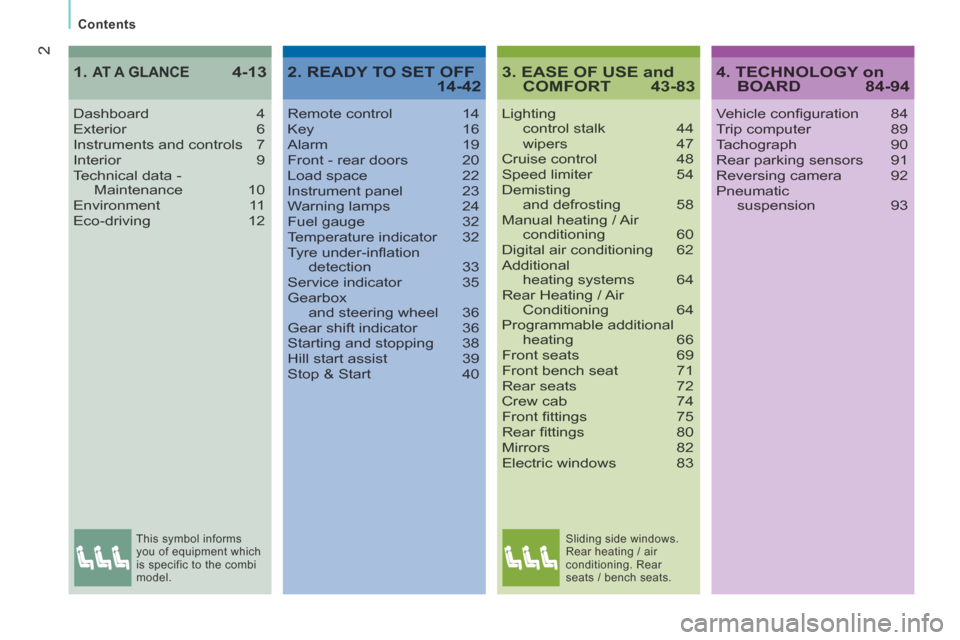
2
Contents
3. EASE OF USE and COMFORT 43-83
Lighting control stalk 44 wipers 47Cruise control 48Speed limiter 54Demisting and defrosting 58Manual heating / Air conditioning 60Digital air conditioning 62Additional heating systems 64Rear Heating / Air Conditioning 64Programmable additional heating 66Front seats 69Front bench seat 71Rear seats 72Crew cab 74Front fi ttings 75Rear fi ttings 80Mirrors 82Electric windows 83
Dashboard 4Exterior 6Instruments and controls 7Interior 9Technical data - Maintenance 10Environment 11Eco-driving 12
1. AT A GLANCE 4-134. TECHNOLOGY on BOARD 84-94
Vehicle confi guration 84Trip computer 89Tachograph 90Rear parking sensors 91Reversing camera 92Pneumatic suspension 93
2. READY TO SET OFF 14-42
Remote control 14Key 16Alarm 19Front - rear doors 20Load space 22Instrument panel 23Warning lamps 24Fuel gauge 32Temperature indicator 32Tyre under-infl ation detection 33Service indicator 35Gearbox and steering wheel 36Gear shift indicator 36Starting and stopping 38Hill start assist 39Stop & Start 40
This symbol informs
you of equipment which
is specific to the combi
model. Sliding side windows.
Rear heating / air
conditioning. Rear
seats / bench seats.
Page 8 of 240
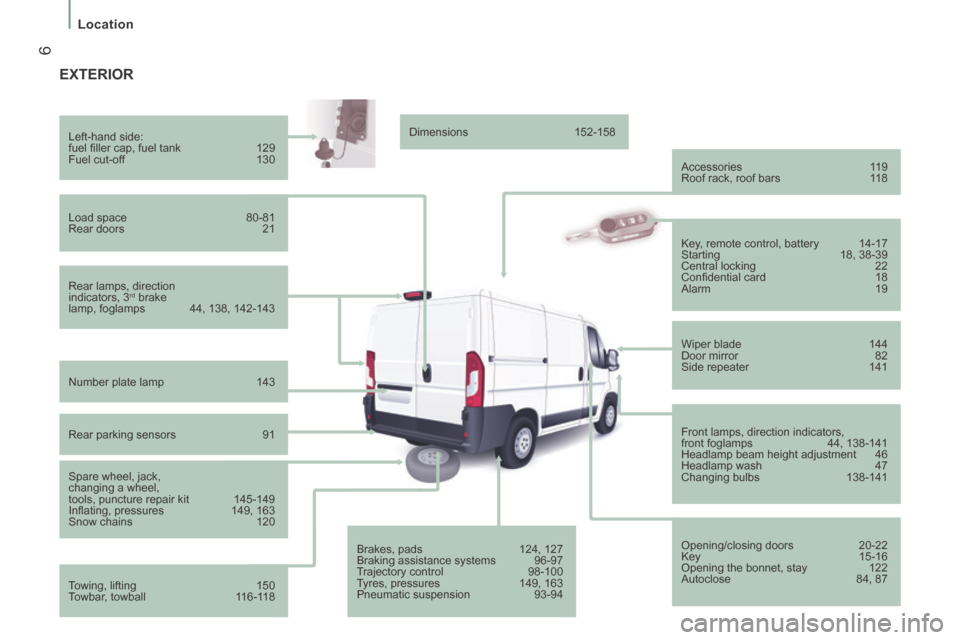
6
Location
EXTERIOR
Rear lamps, direction
indicators, 3 rd brake
lamp, foglamps 44, 138, 142-143 Left-hand side:
fuel fi ller cap, fuel tank 129
Fuel cut-off 130
Load space 80-81
Rear doors 21
Number plate lamp 143
Rear parking sensors 91
Spare wheel, jack,
changing a wheel,
tools, puncture repair kit 145-149
Infl ating, pressures 149, 163
Snow chains 120
Towing, lifting 150
Towbar, towball 116-118 Dimensions
152-158
Accessories 119
Roof rack, roof bars 118
Brakes, pads 124, 127
Braking assistance systems 96-97
Trajectory control 98-100
Tyres, pressures 149, 163
Pneumatic suspension 93-94 Key, remote control, battery 14-17
Starting
18, 38-39
Central locking 22
Confi dential card 18
Alarm 19
Wiper blade 144
Door mirror 82
Side repeater 141
Front lamps, direction indicators,
front foglamps 44, 138-141
Headlamp beam height adjustment 46
Headlamp wash 47
Changing bulbs 138-141
Opening/closing doors 20-22
Key 15-16
Opening the bonnet, stay 122
Autoclose 84, 87
Page 9 of 240
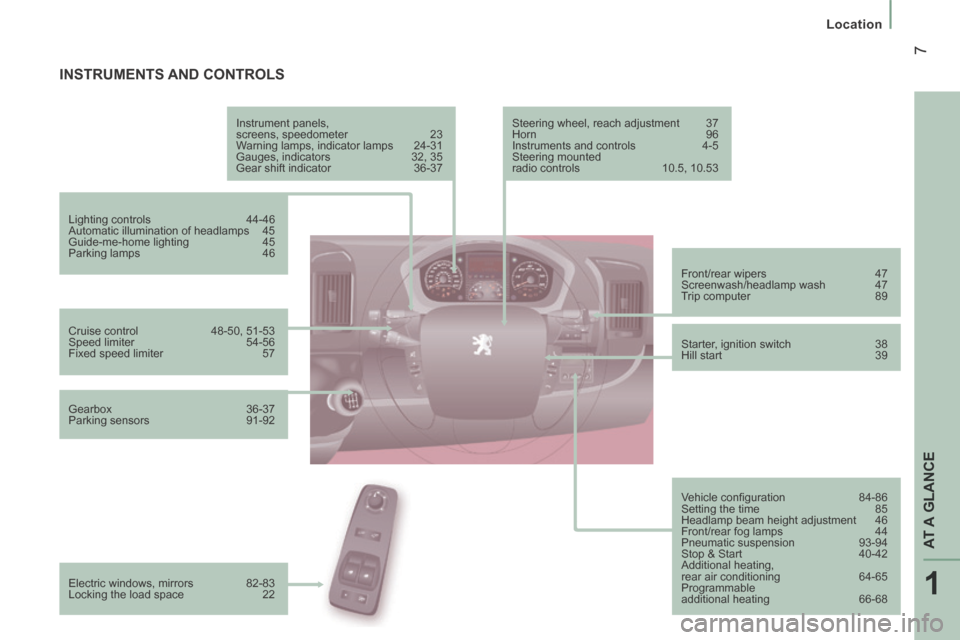
1
AT A GLANCE
7
Location
INSTRUMENTS AND CONTROLS
Instrument panels,
screens, speedometer 23
Warning lamps, indicator lamps 24-31
Gauges, indicators 32, 35
Gear shift indicator 36-37
Lighting controls 44-46
Automatic illumination of headlamps 45
Guide-me-home lighting 45
Parking lamps 46
Vehicle confi guration 84-86
Setting the time 85
Headlamp beam height adjustment 46
Front/rear fog lamps 44
Pneumatic suspension 93-94
Stop & Start 40-42
Additional heating,
rear air conditioning 64-65
Programmable
additional heating 66-68
Front/rear wipers
47
Screenwash/headlamp wash 47
Trip computer 89
Starter, ignition switch 38
Hill start 39
Cruise control
48-50, 51-53
Speed limiter 54-56
Fixed speed limiter 57 Steering wheel, reach adjustment 37
Horn
96
Instruments and controls 4-5
Steering mounted
radio controls 10.5, 10.53
Electric windows, mirrors 82-83
Locking the load space 22
Gearbox
36-37
Parking sensors 91-92
Page 29 of 240
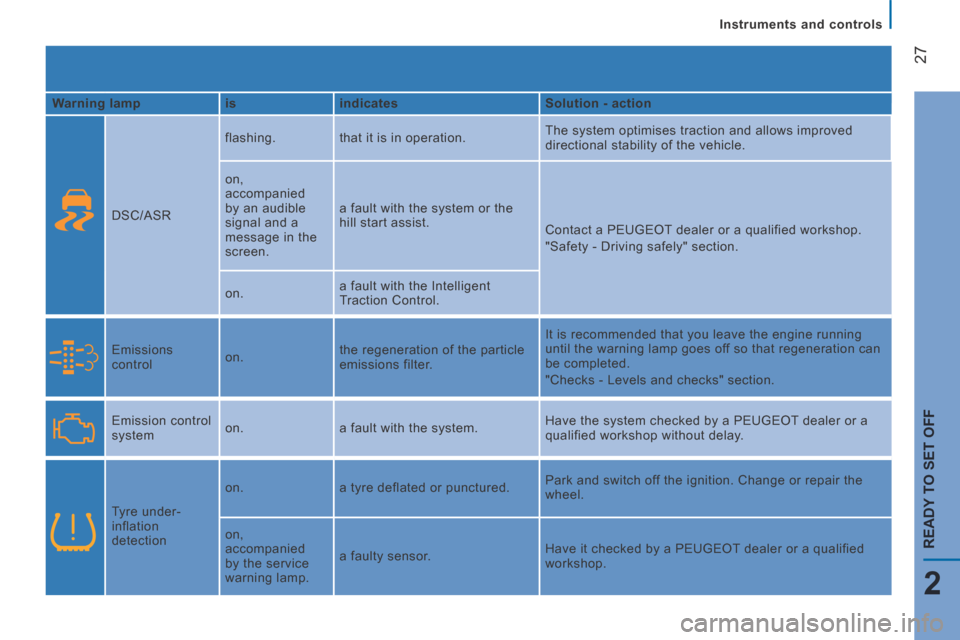
27
2
READY TO SET OFF
Instruments and controls
Warning lamp is indicates Solution - action
DSC/ASR flashing.
that it is in operation. The system optimises traction and allows improved
directional stability of the vehicle.
on,
accompanied
by an audible
signal and a
message in the
screen. a fault with the system or the
hill start assist.
Contact a PEUGEOT dealer or a qualified workshop.
"Safety - Driving safely" section.
on. a fault with the Intelligent
Traction Control.
Emissions
control on. the regeneration of the particle
emissions filter. It is recommended that you leave the engine running
until the warning lamp goes off so that regeneration can
be completed.
"Checks - Levels and checks" section.
Emission control
system on.
a fault with the system. Have the system checked by a PEUGEOT dealer or a
qualified workshop without delay.
Tyre under-
inflation
detection on.
a tyre deflated or punctured. Park and switch off the ignition. Change or repair the
wheel.
on,
accompanied
by the service
warning lamp. a faulty sensor.
Have it checked by a PEUGEOT dealer or a qualified
workshop.
Page 35 of 240
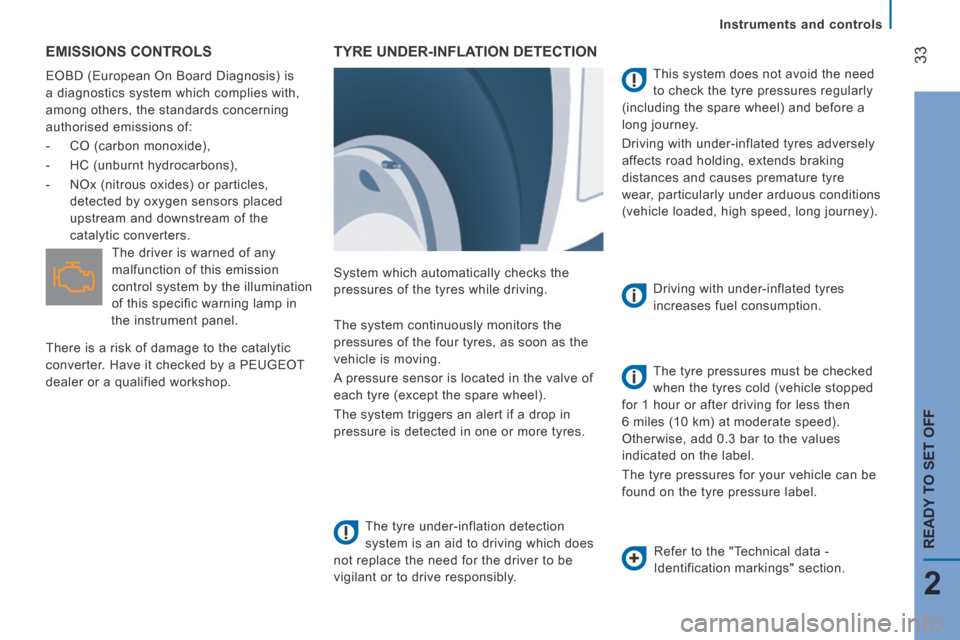
33
2
READY TO SET OFF
Instruments and controls
EMISSIONS CONTROLS
EOBD (European On Board Diagnosis) is
a diagnostics system which complies with,
among others, the standards concerning
authorised emissions of:
- CO (carbon monoxide),
- HC (unburnt hydrocarbons),
- NOx (nitrous oxides) or particles, detected by oxygen sensors placed
upstream and downstream of the
catalytic converters.
TYRE UNDER-INFLATION DETECTION
System which automatically checks the
pressures of the tyres while driving.
The tyre under-inflation detection
system is an aid to driving which does
not replace the need for the driver to be
vigilant or to drive responsibly. This system does not avoid the need
to check the tyre pressures regularly
(including the spare wheel) and before a
long journey.
Driving with under-inflated tyres adversely
affects road holding, extends braking
distances and causes premature tyre
wear, particularly under arduous conditions
(vehicle loaded, high speed, long journey).
Driving with under-inflated tyres
increases fuel consumption.
The system continuously monitors the
pressures of the four tyres, as soon as the
vehicle is moving.
A pressure sensor is located in the valve of
each tyre (except the spare wheel).
The system triggers an alert if a drop in
pressure is detected in one or more tyres. The tyre pressures must be checked
when the tyres cold (vehicle stopped
for 1 hour or after driving for less then
6 miles (10 km) at moderate speed).
Otherwise, add 0.3 bar to the values
indicated on the label.
The tyre pressures for your vehicle can be
found on the tyre pressure label.
The driver is warned of any
malfunction of this emission
control system by the illumination
of this specific warning lamp in
the instrument panel.
There is a risk of damage to the catalytic
converter. Have it checked by a PEUGEOT
dealer or a qualified workshop.
Refer to the "Technical data -
Identification markings" section.
Page 36 of 240
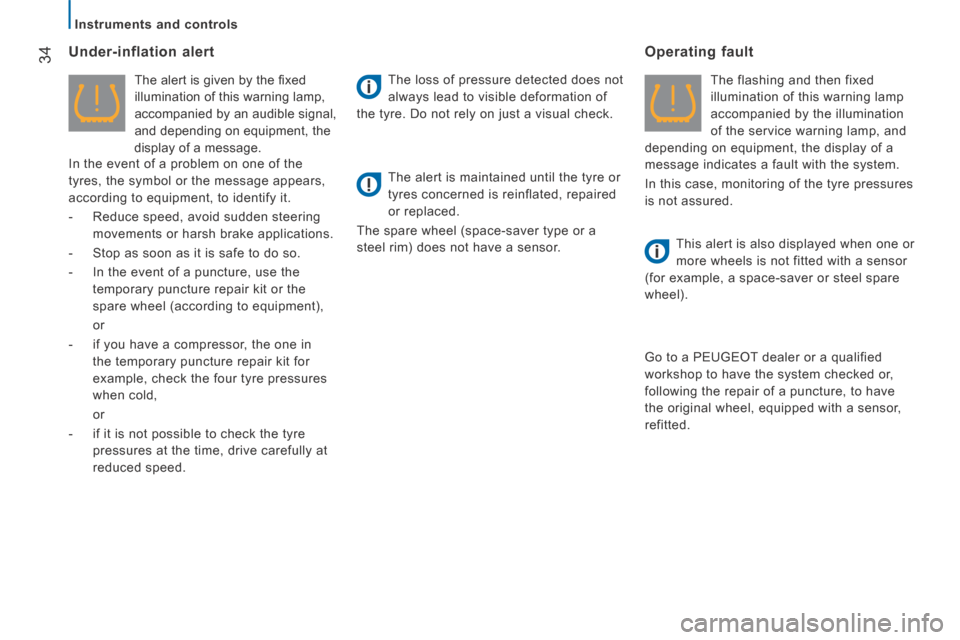
34
Instruments and controls
Under-inflation alert
The alert is given by the fi xed
illumination of this warning lamp,
accompanied by an audible signal,
and depending on equipment, the
display of a message.
In the event of a problem on one of the
tyres, the symbol or the message appears,
according to equipment, to identify it.
- Reduce speed, avoid sudden steering
movements or harsh brake applications.
- Stop as soon as it is safe to do so.
- In the event of a puncture, use the temporary puncture repair kit or the
spare wheel (according to equipment),
or
- if you have a compressor, the one in the temporary puncture repair kit for
example, check the four tyre pressures
when cold,
or
- if it is not possible to check the tyre pressures at the time, drive carefully at
reduced speed. The loss of pressure detected does not
always lead to visible deformation of
the tyre. Do not rely on just a visual check.
The alert is maintained until the tyre or
tyres concerned is reinflated, repaired
or replaced.
The spare wheel (space-saver type or a
steel rim) does not have a sensor.
Operating fault
The flashing and then fixed
illumination of this warning lamp
accompanied by the illumination
of the service warning lamp, and
depending on equipment, the display of a
message indicates a fault with the system.
In this case, monitoring of the tyre pressures
is not assured.
This alert is also displayed when one or
more wheels is not fitted with a sensor
(for example, a space-saver or steel spare
wheel).
Go to a PEUGEOT dealer or a qualified
workshop to have the system checked or,
following the repair of a puncture, to have
the original wheel, equipped with a sensor,
refitted.
Page 38 of 240
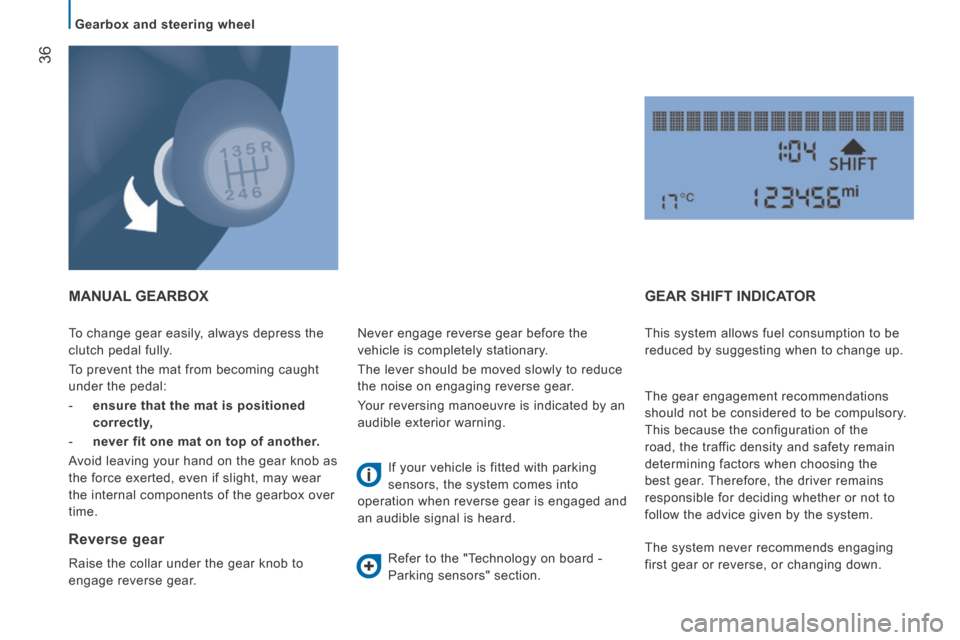
36
Gearbox and steering wheel
To change gear easily, always depress the
clutch pedal fully.
To prevent the mat from becoming caught
under the pedal:
- ensure that the mat is positioned correctly,
- never fit one mat on top of another.
Avoid leaving your hand on the gear knob as
the force exerted, even if slight, may wear
the internal components of the gearbox over
time.
MANUAL GEARBOX
Reverse gear
Raise the collar under the gear knob to
engage reverse gear. Never engage reverse gear before the
vehicle is completely stationary.
The lever should be moved slowly to reduce
the noise on engaging reverse gear.
Your reversing manoeuvre is indicated by an
audible exterior warning.
If your vehicle is fitted with parking
sensors, the system comes into
operation when reverse gear is engaged and
an audible signal is heard.
Refer to the "Technology on board -
Parking sensors" section.
GEAR SHIFT INDICATOR
This system allows fuel consumption to be
reduced by suggesting when to change up.
The gear engagement recommendations
should not be considered to be compulsory.
This because the configuration of the
road, the traffic density and safety remain
determining factors when choosing the
best gear. Therefore, the driver remains
responsible for deciding whether or not to
follow the advice given by the system.
The system never recommends engaging
first gear or reverse, or changing down.
Page 47 of 240
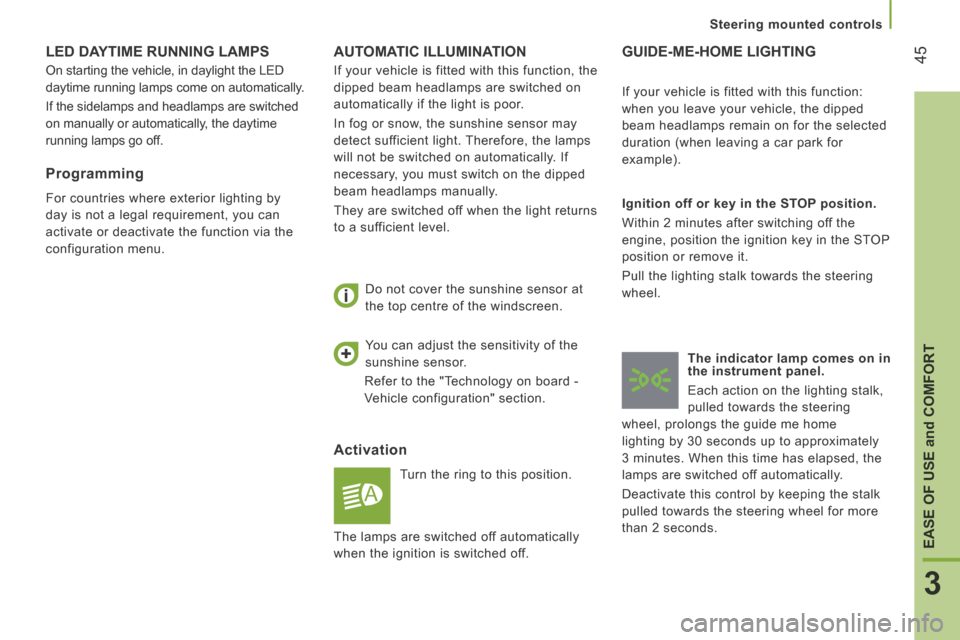
45
3
EASE OF USE
and
COMFORT
Steering mounted controls
AUTOMATIC ILLUMINATION
Activation
Turn the ring to this position.
Do not cover the sunshine sensor at
the top centre of the windscreen.
GUIDE-ME-HOME LIGHTING
Ignition off or key in the STOP position.
Within 2 minutes after switching off the
engine, position the ignition key in the STOP
position or remove it.
Pull the lighting stalk towards the steering
wheel.
The indicator lamp comes on in
the instrument panel.
Each action on the lighting stalk,
pulled towards the steering
wheel, prolongs the guide me home
lighting by 30 seconds up to approximately
3 minutes. When this time has elapsed, the
lamps are switched off automatically.
Deactivate this control by keeping the stalk
pulled towards the steering wheel for more
than 2 seconds. If your vehicle is fitted with this function:
when you leave your vehicle, the dipped
beam headlamps remain on for the selected
duration (when leaving a car park for
example).
You can adjust the sensitivity of the
sunshine sensor.
Refer to the "Technology on board -
Vehicle configuration" section.
If your vehicle is fitted with this function, the
dipped beam headlamps are switched on
automatically if the light is poor.
In fog or snow, the sunshine sensor may
detect sufficient light. Therefore, the lamps
will not be switched on automatically. If
necessary, you must switch on the dipped
beam headlamps manually.
They are switched off when the light returns
to a sufficient level.
LED DAYTIME RUNNING LAMPS
On starting the vehicle, in daylight the LED
daytime running lamps come on automatically.
If the sidelamps and headlamps are switched
on manually or automatically, the daytime
running lamps go off.
Programming
For countries where exterior lighting by
day is not a legal requirement, you can
activate or deactivate the function via the
configuration menu.
The lamps are switched off automatically
when the ignition is switched off.